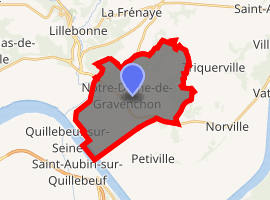Notre-Dame-de-Gravenchon
Notre-Dame-de-Gravenchon is a former commune in the Seine-Maritime department in the Normandy region in northern France. On 1 January 2016, it was merged into the new commune of Port-Jérôme-sur-Seine.[2]
Notre-Dame-de-Gravenchon | |
|---|---|
Part of Port-Jérôme-sur-Seine | |
Location of Notre-Dame-de-Gravenchon 
| |
 Notre-Dame-de-Gravenchon  Notre-Dame-de-Gravenchon | |
| Coordinates: 49°29′24″N 0°34′19″E | |
| Country | France |
| Region | Normandy |
| Department | Seine-Maritime |
| Arrondissement | Le Havre |
| Canton | Notre-Dame-de-Gravenchon |
| Commune | Port-Jérôme-sur-Seine |
| Area 1 | 18.74 km2 (7.24 sq mi) |
| Population (2017)[1] | 8,634 |
| • Density | 460/km2 (1,200/sq mi) |
| Time zone | UTC+01:00 (CET) |
| • Summer (DST) | UTC+02:00 (CEST) |
| Postal code | 76330 |
| Elevation | 0–138 m (0–453 ft) (avg. 35 m or 115 ft) |
| 1 French Land Register data, which excludes lakes, ponds, glaciers > 1 km2 (0.386 sq mi or 247 acres) and river estuaries. | |
Geography
A small town with a huge industrial area (Port-Jérome) to the southwest with farming and woodland to the north and east, in the Pays de Caux, situated by the banks of the river Seine, some 20 miles (32 km) east of Le Havre, at the junction of the D81, D373 and D110 roads.
History
- The parishes of Saint-Georges-de-Gravenchon and Notre Dame were part of the royal domain of Lillebonne. The Counts of Évreux built the medieval castle of Fontaine-Saint-Denis. The two parishes were joined as one commune in 1823 under the name of Notre-Dame-de-Gravenchon.
- Napoleon III opened the new industrial area of Port-Jérôme. A commemorative stone recalls his visit on May 28, 1861. Until then, the commune was an agricultural town.
- In 1930, two oil refineries with two separate housing districts were established. "Standard" (for Esso employees) and "Vacuum" (for Mobil Oil's workers).
- During World War II, the refineries were partly destroyed (1940) but rebuilt after 1945. Notre Dame de Gravenchon was occupied by the Germans on 12 June 1940 and liberated on 31 August 1944 jointly by the British and Belgian armies (Brigade Piron).[3]
Heraldry
 Arms of Notre-Dame-de-Gravenchon |
The arms of Notre-Dame-de-Gravenchon are blazoned : Per fess 1: per pale A: gules, a demi-lion issuant from the per pale line and B: Azure, the outline of a drakkar on waves argent; and 2: Vert, 2 stalks of wheat in saltire argent and in chief 3 chemical flasks outlined, and half full argent, middle one largest; all the lines of division fimbriated. |
Population
| 1962 | 1968 | 1975 | 1982 | 1990 | 1999 | 2006 |
|---|---|---|---|---|---|---|
| 5488 | 6273 | 8335 | 8963 | 8901 | 8618 | 8541 |
| Starting in 1962: Population without duplicates | ||||||
Places of interest
Twinning
Notre Dame de Gravenchon is twinned with Street, a village in Somerset, a county in the south west of England and Isny im Allgäu a city in the South of Baden-Würrtemberg, Germany
gollark: Is good
gollark: Artist doesn't log as excessively as correctly configured potatOS!
gollark: In a proprietary binary format also used for the potatOS Registry.
gollark: PotatOS with extended monitoring turned on logs every event but timers.
gollark: It's actually the potatOS logs storage.
References
- Téléchargement du fichier d'ensemble des populations légales en 2017, INSEE
- Arrêté préfectoral 30 November 2015 (in French)
- armées.com. "Armées.com - Escape Report Sgt Nekervis". Xn--armes-dsa.com. Retrieved 2013-03-26.
External links
| Wikimedia Commons has media related to Notre-Dame-de-Gravenchon. |
- Official website of the commune (in French)
This article is issued from Wikipedia. The text is licensed under Creative Commons - Attribution - Sharealike. Additional terms may apply for the media files.